Wedding cake designers have the enviable job of helping newlywed couples to celebrate one of life’s major milestones. Of course, along with that honor comes an enormous responsibility!
Wedding cake designers have to deliver delicious and beautiful creations to couples, weekend after weekend. And there are no do-overs! So they have to ensure they get it right.
If you’re interested in a career as a wedding cake designer, here’s what you should know.
Start With the Basics
There is a visual component to all cooking, but nowhere is this so prominent as in the wedding cake industry. Cake designers have to bake delectable cakes while also creating a showpiece for their client couples. This requires baking techniques, imagination, and decorative skills like frosting, piping, and making sugar flowers.
Former Escoffier Chef Instructor and expert wedding cake designer Steve Konopelski says, “The challenge in the wedding cake world is that your wedding cake needs to be sculptural and attractive, but it’s also dessert. So it has to be tasty. I think the hardest part of being a wedding cake designer is creating that balance between sculpture and flavor.”
So how can an aspiring cake baker and designer gain these technical skills? The answer is a Baking & Pastry Arts program.
Escoffier students explore a number of baking and pastry disciplines via this program. The Cake Design & Decorating course, for example, is all about cakes, from mixing methods and cake styles to basic icings, frosting, fondant, and assembly, to delicate piping and decoration.
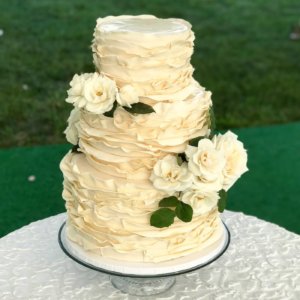
A three-tiered “ruffled” cake by Chef Steve Konopelski
In cake decorating classes, students work on repetition. They won’t pipe one frosting flower—they’ll pipe hundreds. They’re training their bodies to do the work automatically, building muscle memory with a variety of piping tips. Just like practicing with a chef’s knife in a Culinary Arts program, Baking & Pastry students must practice to gain mastery over their piping bags.
After they’ve completed their programs, all Baking & Pastry students must complete a pastry externship. Aspiring cake decorators can seek work in a wedding cake bakery where they’ll be able to see how a bakery is run and continue to practice their skills.
“My experience in the Pastry Arts program made all the difference for me. I went into the program as a good baker; I came out a professional baker.”Stacy Walker, Escoffier Boulder Pastry Arts Graduate & Co-Owner, Happy Bakeshop
Establish Your Signature Style
When you become a wedding cake designer, it can be tempting to try to please everyone. One client may ask you for a very minimalist cake, while another wants an elaborate creation, covered in thousands of tiny decorations. Or a potential client may bring in a picture they found online and ask you to recreate it for them.
But, as Chef Steve says, “If you say you can make anything, you’ll never do anything good.”
The big names in wedding cakes, like Ron Ben-Israel and Sylvia Weinstock, each have a signature style. It’s why they’re so successful—and why they can charge such high prices. While your goal may not be to make wedding cakes for the elite, you should still have your own style. You’ll have to decide what you do best.
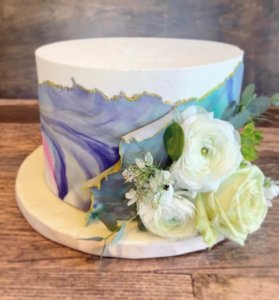
An original watercolor design by Chef Steve Konopelski
Plus, recreating other cake designs is incredibly difficult!
“I think there are 45 different shades of gold luster dust,” says Chef Steve. “So you can’t promise the gold cake that you’re seeing in the photo.” Instead, he suggests you ask “What are the elements of this cake that you like?” Design their cake with those elements, while incorporating your own distinctive style.
“It’s okay to say no when the gig doesn’t work with your brand. Because if you say you can deliver a fire-breathing dragon, you’d better deliver. If you don’t, that will follow you forever.”Chef Steve Konopelski, Former Escoffier Baking & Pastry Chef Instructor and Wedding Cake Designer
Build a Cake Design Portfolio
Once you have your education and you’re starting to establish your style, what’s next?
To secure clients, you’ll need a portfolio that shows what you’re capable of and what your cakes look like. This will consist of high-quality photos of your designs that you can post on your website. Team up with a new wedding photographer who needs to build their own portfolio too, so you can help each other.
“There’s a lot of give and take in the wedding industry,” says Chef Steve. “You may have to make some dummy cakes and have a photo session [to build your portfolio].”
You can also take photos in a lightbox to create a studio feel. And don’t be afraid to cut into that pretty cake. Shoot a slice so viewers can see the lovely layers and start thinking about what it must taste like.
In general, Chef Steve says that the modern trend is for smaller, simpler cakes, rather than huge over-the-top creations. So you may also want to include some smaller items in your portfolio, like sweetheart cakes or even individual mini cakes.
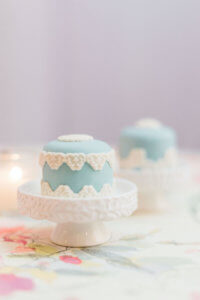
Mini cakes by Chef Steve Konopelski
“We’re way out of the era of the 9-tier wedding cake. Even Prince Harry and Meghan Markle had a simple sweetheart cake.”Chef Steve Konopelski, Former Escoffier Baking & Pastry Chef Instructor and Wedding Cake Designer
Secure Clients: Tastings and Sketches
Once a potential client has decided they like your designs, they’re going to want to taste what you have to offer!
At Chef Steve’s bakery in Maryland, they provided eight full slices of cake at tastings. Another cake decorator we spoke to had an even more elaborate setup. He made five cake flavors—plain, honey almond, coffee, lavender, and vanilla. These were laid out with fruit fillings, buttercream, chocolate ganache, and more, so the couple could combine their own custom flavors.
As they taste, the couple and the designer will chat about the wedding style. The venue, linens, and outfits can all inspire the cake’s design.
“There’s a mood for the entire party,” says Chef Steve. “And the cake, in sculptural form, should be part of that. Is the feel modern upscale? Is it retro casual? Boho?”
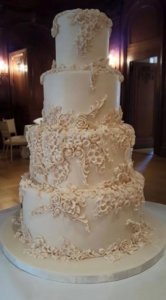
A cake with detailed piping work by Chef Steve Konopelski
Grab some paper and sketch out your ideas with the couple. If they brought inspiration photos, ask them which elements they like from those and incorporate what you can, while still keeping true to your own style. You’re the professional, and that’s why they came to you. So you may need to gently lead the client to what you think will be best, while also respecting their wishes and preferences.
Chef Steve’s good friend was getting married, and she told him she wanted the wedding to be easy and relaxed. But when Chef Steve dug into the details, he learned that her gown was Vera Wang couture, and the venue was very high-end, covered in gold Baroque details.
“She wanted a clean buttercream cake. I just said, ‘I’m sorry, you can’t have it. I won’t allow it,’” he laughs. “That does not belong at this wedding. But I get that we’re looking for simplicity. So we created a four-tier, custom hand-molded floral cake. But it was monochromatic, so it still felt casual with a clean color palate.”
“When you have confidence in your ability and know what your strength is, people are going to come to you.”Chef Steve Konopelski, Former Escoffier Baking & Pastry Chef Instructor and Wedding Cake Designer
The Big Day
Part of being a successful wedding cake designer is communication. A week or two before the wedding, you’ll need to reach back out to the couple to confirm all the details—flavors, design, decoration, venue, and arrival time. Since your initial consultation may have been months ago, you’ll have to keep careful records about what you and the couple decided for the cake.
You may also want to visit the venue if you’ve never been there before. If you have to climb a hill with a three-tier wedding cake, you’ll want to know that in advance! Cakes are often assembled and finished on-site to prevent being damaged in transport. So you’ll also need a careful checklist to ensure that you have everything you need to complete your finished product.
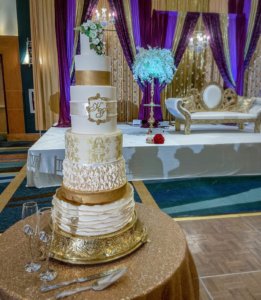
This seven-tiered cake by Chef Steve Konopelski was assembled on-site.
Another element to consider is the venue setting, including potential conditions. Is it an indoor or outdoor reception? Will it be humid? Does the couple want the cake out during the whole reception? Chef Steve refused to do buttercream during outdoor summer weddings. He isn’t just being stubborn—he’s looking out for the client. Buttercream will melt in a hot, humid environment and ruin the look of the cake. You can work these kinds of details into your client contract.
Once the cake is delivered and assembled, your work is nearly complete! Provide instructions on cutting the cake to the caterer, and you can celebrate a job well done. In the following weeks, remember to ask for testimonials, reviews, and referrals from thrilled clients for your portfolio.
Practice, Practice, Practice
If you plan to become a wedding cake designer, you’ll need education and lots of practice. You can get a head start on both with a Baking & Pastry Arts education at Escoffier. With programs offered in Boulder, Austin, and online, you can practice perfect sponges and delicate line work from anywhere.
Start learning from experienced chef mentors and working toward a sweet career in cakes!
To learn more about careers in baking and pastry, try these articles:

